
Roxana Aldea
- Position
- Postgraduate Research Student
- Institution
- Mathematics (FSHS)
- ra4g13@soton.ac.uk
- Contact
- Complete this online contact form to contact Roxana.
I am a PhD student at Institute for Complex Systems Simulation. This research programme is fully supported via an EPSRC International Doctoral Studentship.
I am part of a research group focused on the pathogenesis of Alzheimer's Disease (AD), a multifactorial disorder. AD is the most common form of dementia for which, yet, there is no cure. One of the hallmarks of AD is the accumulation of toxic A? proteins in the extracellular space of neurons, but also within the cerebral arterial wall as cerebral amyloid angiopathy. One of the pathways for clearing solutes (e.g. A? protein) out of the brain has been identified to be the basement membrane of cerebral arteries and capillaries. The process of clearing A? along the cerebrovascular basement membranes, also known as perivascular drainage, fails with age. Thus, during ageing the human brain is prone to increased accumulation of A? within the arterial wall. Therefore, the relationship between AD and cerebrovascular diseases has been gaining an increased importance. In order to clarify better the pathogenic mechanisms and to provide efficient therapies for such a devastating, lethal disease, a multidisciplinary approach is of paramount importance. My contribution as a physicist involves development of biophysical and mathematical models for the biomechanics of cerebral blood vessels and their role in perivascular drainage of solutes from the brain. My supervisors are Dr Giles Richardson (Mathematics) and Dr Roxana Carare (Medicine).
I am a physicist, with a high interest in Biophysics and Biomedicine, especially in Regenerative Medicine and Tissue Engineering. I graduated from West University of Timisoara, Romania with a Diploma Thesis in Physical Methods in Computational Modelling of Tissue Morphogenesis. A review paper about different computational methods for in vitro morphogenesis is Computer simulations of in vitro morphogenesis
During my Master degree I studied one year at University of Groningen, The Netherlands. I did my Master Dissertation within the Cardiovascular Regenerative Medicine Research Group, investigating from a computational perspective a new, revolutionary hypothesis for atherosclerosis development. The computational model that I used in my research was Cellular Potts Model.
I am based in Mathematics Building (Bd 54), room 6007.
Working with...
 Roxana-Octavia Carare Roxana-Octavia CarareSenior Lecturer, Medicine (FM) |
 Giles Richardson Giles RichardsonReader, Mathematics (FSHS) |
Gallery

Solutes, such as A?, are cleared away from the brain along the basement membrane (blue) of vascular smooth muscle cells (red line) comprised in the wall of cerebral blood vessels. The perivascular drainage starts at the capillaries level within the brain parenchyma and continues towards larger arteries on the surface of the brain, in the reverse direction of blood flow and arterial pulsations (red arrows)